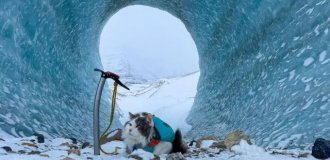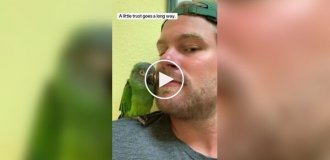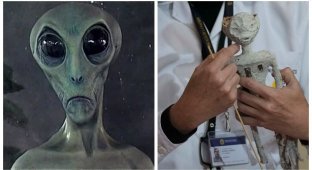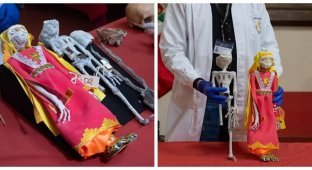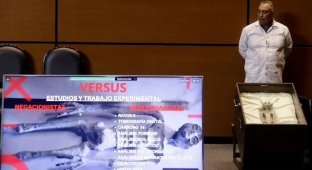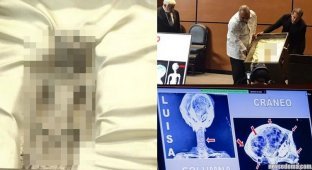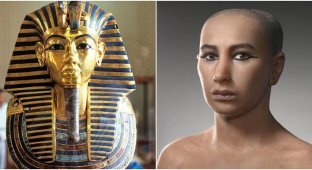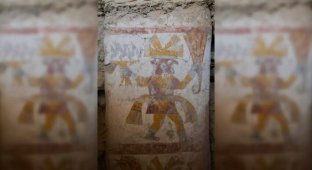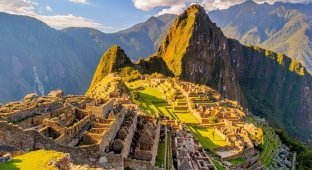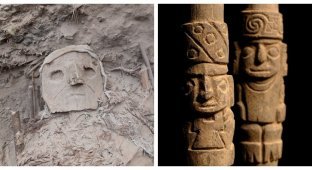Two new exclusive “alien” mummies from Peru have been discovered (12 photos)
A Mexican journalist who claims to have discovered alien bodies in the Peruvian desert has turned to American and European scientists to confirm their authenticity. 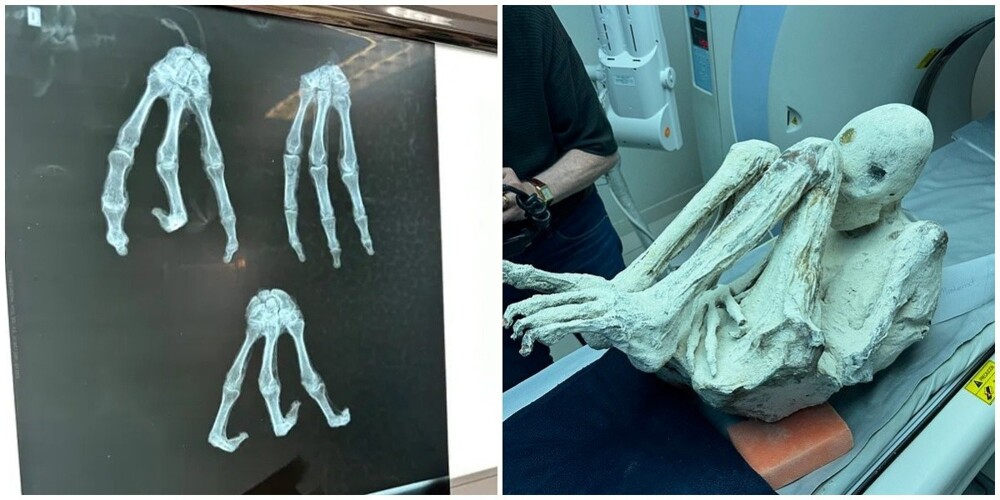
Two recently discovered "alien" mummies from Peru have sparked controversy after X-ray and ultrasound data on the bodies were made public in March this year. Archaeologists fear they could be ancient people discovered by tomb robbers.
Journalist and UFO researcher Jaime Maussan told DailyMail.com that deeper "analyses" are being carried out. He is suing the Peruvian government for the right to send the bodies to more modern laboratories in the United States to determine the identity of the “aliens.” Maussan, whose research has been controversial for nearly a decade, has floated the idea that the mummies could be alien-human "hybrids" and fellow scientists have said the new samples contain "30 percent unknown" DNA. But critics still continue to doubt his claims.
"I don't believe they are humanoid. I think they are human," Latin American historian Christopher Heaney told DailyMail.com. 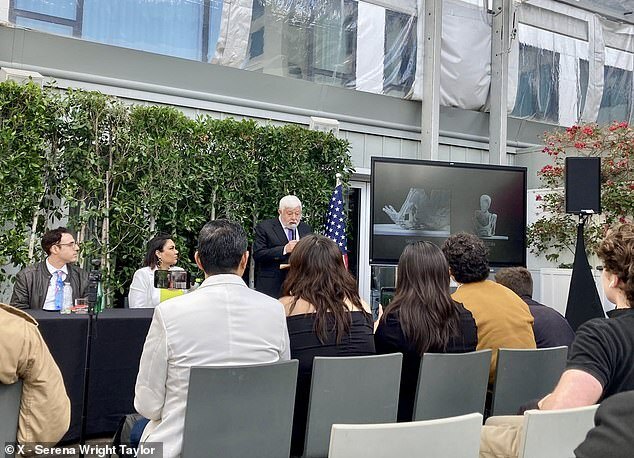
"So far we have tomograms [computed tomography scans] and fluoroscopic analysis," Maussan told DailyMail.com, describing the X-ray and ultrasound data he presented at the Mondrian Hotel in West Hollywood at a press conference on March 12. 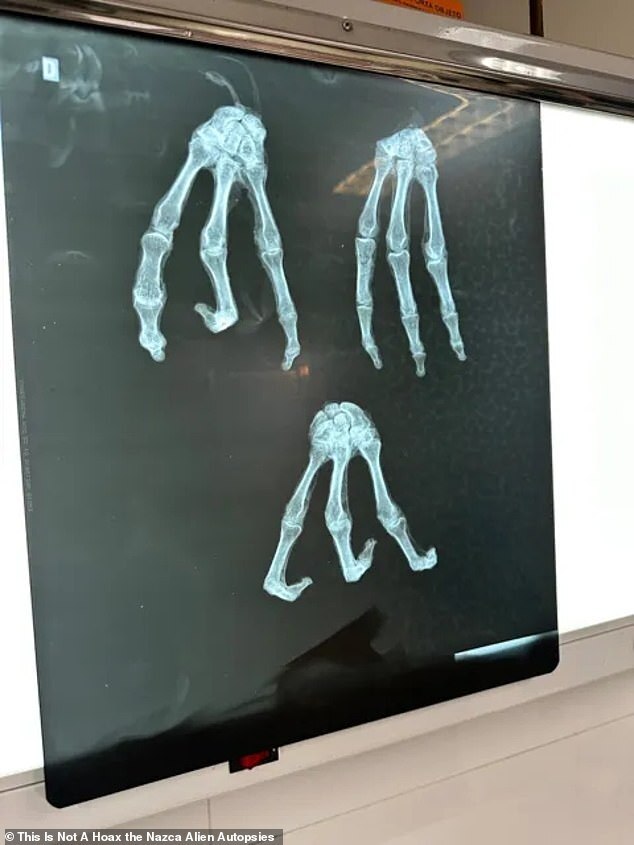
So far, Maussan and his partners report that they have been able to conduct X-rays (above), DNA analysis and other laboratory tests on one of the apparently mummified bodies. The research was conducted in collaboration with US scientists on site in Mexico and Peru. 
A month later in April of this year in Peru - as part of a second event also hosted by ufologist Jaime Maussan - a new example of the "alien" called Montserrat was presented.
Jaime Maussan and his colleagues have spent an eventful year pushing for broader scientific interest in “alien” bodies, including a controversial appearance in the Mexican Congress and clashes with the Peruvian Ministry of Culture.
The drama over the bodies comes as public debate about UFOs explodes, with politicians in the US following government whistleblowers and Ivy League scientists in calling for more open research into the mystery.
Maussan's clash with critics came to a head in April this year when police stormed a press conference he was holding in Peru, intent on seizing one of the mummified bodies on display, dubbed "Montserrat".
Undeterred, Maussan sued the Peruvian government, demanding damages and the right to send these mummies to university researchers and other scientists in the United States for more thorough, independent third-party testing.
“The claim is already worth $300 million. We are going to negotiate with Peru,” Maussan said, “to be allowed to export samples for research in America.”
This Sunday, in an address broadcast to listeners of his program "No Humano", Jaime Maussan added that it will take eight months to obtain new information about the legal battle, which, as he emphasized, will finance a museum for mummies and not bring profit to him personally.
Research is currently ongoing in Mexico. Jaime Maussan's research team included Dr. Martin Achirika Ramos of the SPES alternative health clinic in Mexico City, who worked on the team's other "alien" mummies.
Previous samples were presented to the Mexican Congress last September, sparking interest from a NASA contractor in the US, Maussan told DailyMail.com.
Maussan and Dr Achirika announced on Sunday that specialist doctors in Europe would soon carry out DNA tests on these mummies: "We will not name names so that more DNA tests can be done." Scientists plan to analyze each of the bodies. 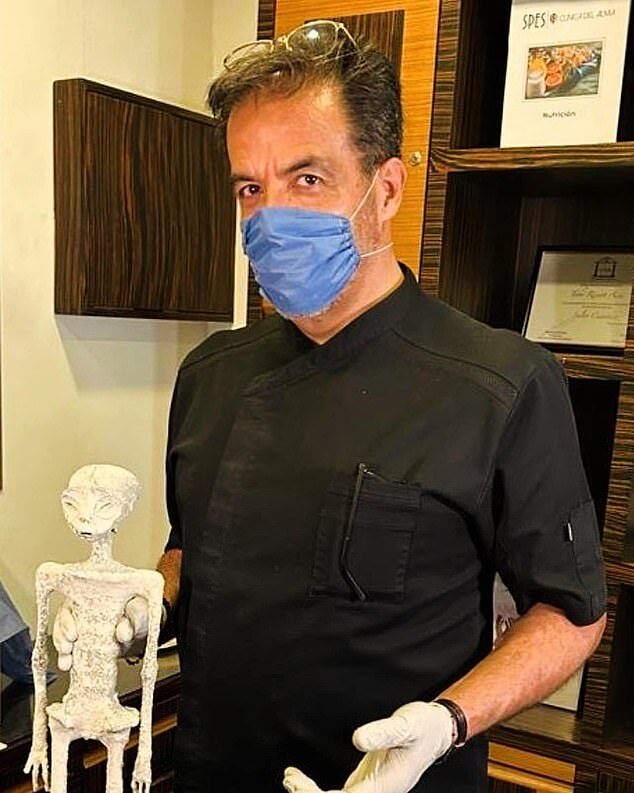
While the legal battle over the relocation of some of the mummies drags on, testing continues in Mexico, where one of Maussan's co-authors, Dr. Martin Achirika Ramos of the SPES alternative health clinic in Mexico City, has been working on other "alien" mummies.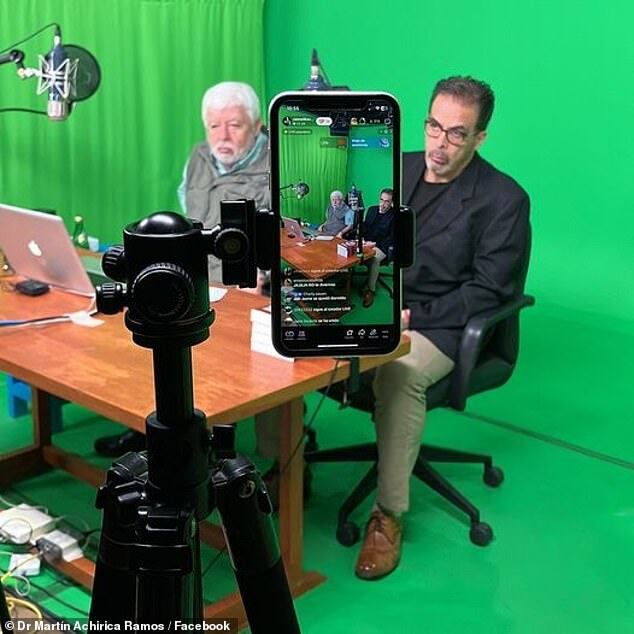
In an updated episode aired this Sunday for listeners of his No Humano program, Maussan (left) and Dr. Achirika (right) added that it will take eight months to achieve new results in this legal battle.
Dr. Achirika added that further details will be revealed on June 15, as part of the launch of his new book "Expediente abierto" ("Open File"), which promises to reveal "the whole truth about non-human bodies from the Nazca Desert." But archaeologists and historians who have dedicated their careers to studying the world of ancient Peru continue to criticize the idea.
Heaney, a Latin American historian at Pennsylvania State University, stressed that the bodies are not as “alien” as they seem.
In his opinion, first, the practice of "head binding" among some cultures living in the Andean mountains of Peru was well documented by both Spanish colonists and local peoples. No evidence links this practice, or the elongated, "alien" heads, to indigenous myths or legends about creatures from the sky, stars, or anywhere else.
Second, according to Heaney, centuries of international tomb robberies, thefts, restorations, haphazard reburials and black market trade in both real and fake Peruvian "antiquities" have sown deep confusion about the country's historical artifacts.
"But in a general sense it's part of a larger problem," Heaney added, "the feeling that we need to dig up the dead to find out more about them." 
Flavio Estrada (right), a forensic archaeologist at the Lima State Ministry's Institute of Legal Medicine and Forensics, said the alien bodies are "dolls" made from animal parts 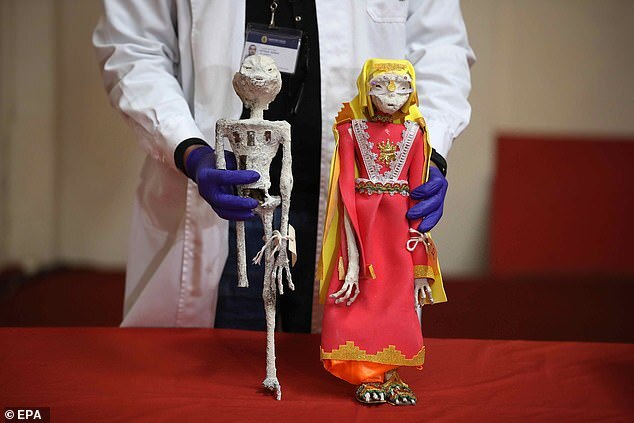
In October 2023, two specimens resembling small mummies were seized at Lima airport and were about to be sent to Mexico. Maussan stated that they did not resemble his own samples. 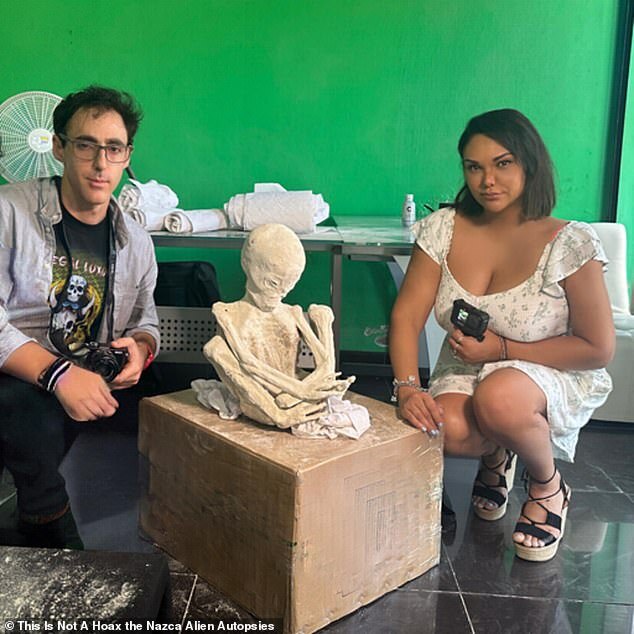
Above, two of Maussan's collaborators, documentary producers Serena DC (right) and Michael Mazzola (left), pose with a new "alien" mummy that they say is made up of 30 percent "unknown" DNA.
Heaney, who last year published a book about Peru's Incan mummies, Empires of the Dead, told DailyMail.com that the region's extensive history of black market tomb robberies adds to his doubts.
"Tomb looting is as old as the Spanish invasion of Peru in 1532. One of the first things the conquistadors noted was that Andean lords, Inca emperors and empresses were buried with great wealth. Tomb looting, if only you reported it to the colonial government and if the Spanish crown received a share of the wealth found, gold, silver and other items were absolutely legal," Heaney explained in a telephone interview.
The result of nearly 500 years of aggressive tampering with Peru's ancient archaeological record has been the accidental displacement of priceless real ancient artifacts by crafts that may interest foreigners in the antiquities market.
In 2022, archaeologists reported the discovery of nearly 200 cases in which the scattered remains of Peruvian mummies, their dorsal vertebrae, were removed by local residents and strung on reed-like posts as fresh memorials.
Carbon dating revealed that these homemade spinal memorials were historical artifacts in their own right, having been collected between 1450 and 1650 AD, during the conquest and collapse of the Inca Empire. 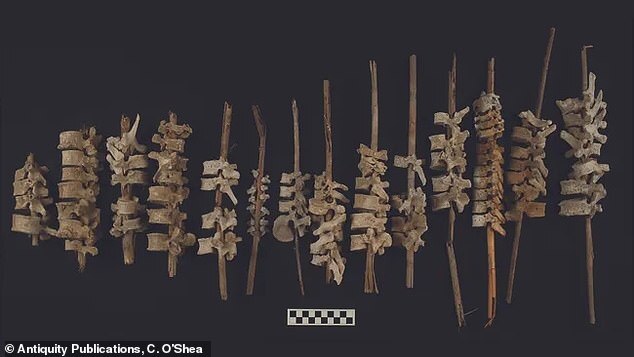
In 2022, archaeologists reported finding nearly 200 cases in which the scattered, disturbed remains of Peruvian mummies, their dorsal vertebrae, were preserved and then strung on reed posts as memorials. Shown above are examples of such memorials discovered in Peru's Chincha Valley, one of many examples of the region's complex archaeological record. 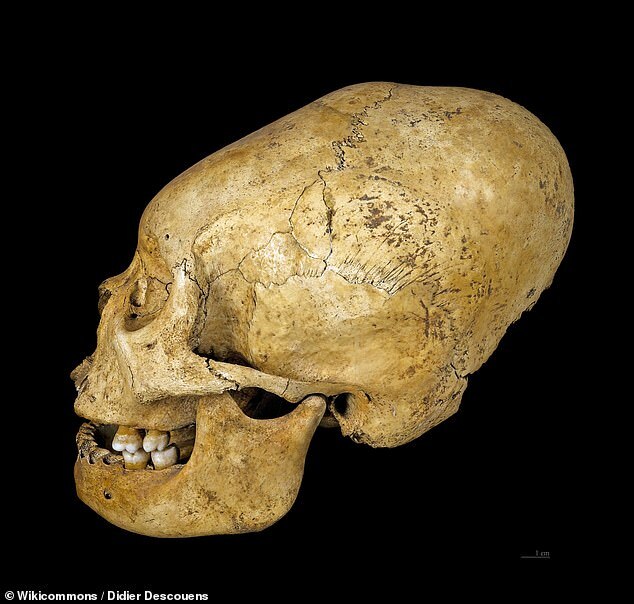
Above is one example of deliberate deformation of a skull from the Proto-Nacian culture in Peru, dating from 200-100 BC, which is now preserved in the Toulouse Museum in France.
"The fact that there are 192 of them and that they are widespread," archaeologist Jacob Bongers told Live Science, "means that this interesting practice was considered an appropriate way to deal with the disturbed bodies of the dead."
Heaney of the University of Pennsylvania added that similar repurposing of remains from robbed graves continues to this day.
“Sometimes in markets in Peru and even the United States you will see dolls for sale that are essentially made from fragments of pre-Hispanic textiles left over from looted graves,” Heaney said, “which are taken and woven to create an ‘old doll’.”
In 2013, for example, archaeologists working for Peruvian customs seized seven pieces of mail containing old coins and replica pre-Columbian dolls made from ancient fabric. All these things were allegedly stolen from archaeological excavations.
Gladys Collatupa, an archaeologist tasked with inspecting packages at a Peruvian post office, told The New York Times that she gradually learned to identify these pre-Hispanic fabrics not only by their patterns and weaves, but also by their feel.
According to her, the ancient fabrics became unusually smooth and soft with age. Chancay funerary dolls, which were originally produced by people living on the central coast of Peru from approximately 1000 to 1450 AD, are one of the artifacts often recreated using these authentic ancient scraps of fabric. 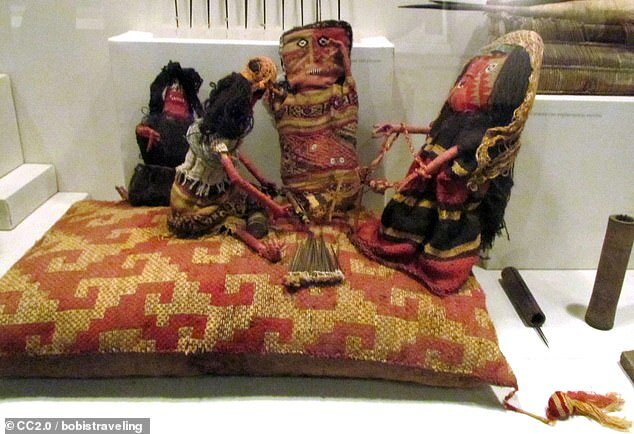
Archaeologists working with Peruvian customs seized mail containing replicas of pre-Columbian dolls made from ancient fabric that were looted from archaeological sites. Above are examples of replicas of Peruvian funerary dolls from Chancay sold to tourists.
Let's get back to mummies. Scientist Heaney emphasized that many of the "alien" mummies found with long, oblong heads are people who practiced head binding. This practice was common for thousands of years before the arrival of the Spanish and Portuguese on the American continent.
"There is no mystery about this, according to the 16th-century Spaniards and Andean people who wrote that it was a common practice. Various Andean populations for more than two millennia engaged in the practice of having their children's skulls bound with bandages or other compressive devices, to change the shape of the head and create a shape that is attractive to them,” Heaney told DailyMail.com. 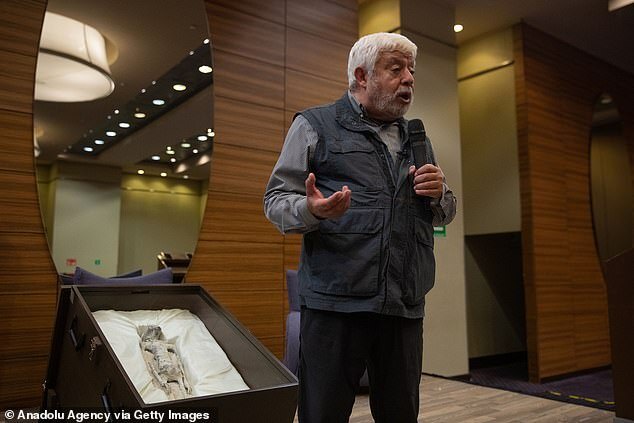
Maussan sought wider scientific interest in apparently alien bodies, including a presentation to the Mexican Congress (pictured). "Do you really think I'm going to take bodies to the Mexican Congress, jeopardizing 50 years of [my journalistic] career to present fake bodies?" he asked at a recent press event in March this year.
The historian added that it is very unlikely that the local population turned to this practice under the influence of visits from long-headed aliens, because there are no stories about such creatures in the folklore of the region.
“The Andean peoples throughout time have not had stories about flying creatures in the sky. They have no stories describing creatures with such heads. What they have are stories about mountains,” he added, “water, natural landscapes, lightning.” and the sun, which fits very well with the archaeological evidence," Heaney told DailyMail.com.
One of the most thorough studies of this practice was conducted by Cornell University anthropologist Matthew Velasco. Maussan and his co-authors, however, insist that their examination of these mummified remains using medical CT scanning and other equipment confirms that they are not from this Earth. Despite the data that was published earlier.
"If I was faking it, I wouldn't put it out there for everyone to see. Do you really think I would take bodies to the Mexican Congress, jeopardizing 50 years of [my journalistic] career, to present fake bodies?" Maussan said. at his press conference in March this year.


